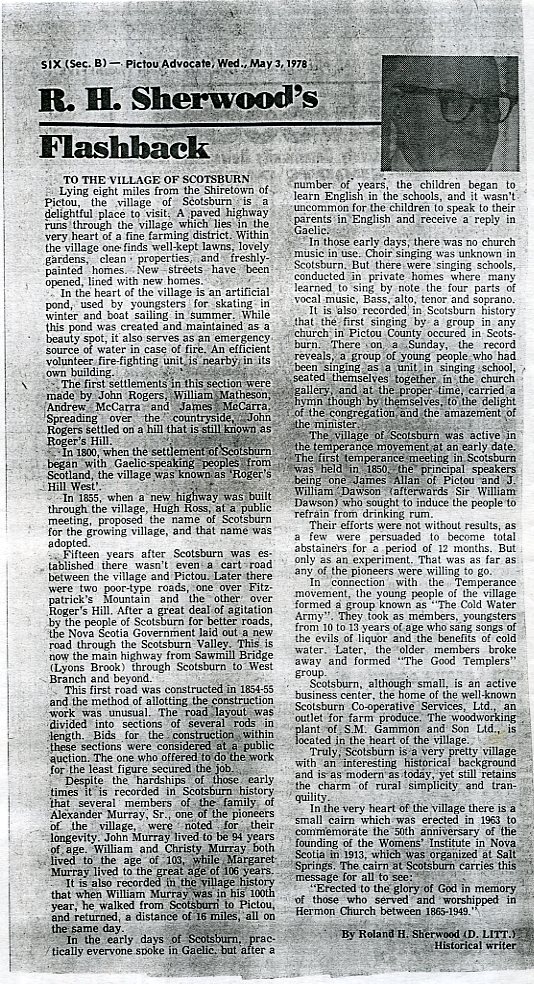
Flashback
TO THE VILLAGE OF SCOTSBURN
Lying eight miles from the Shiretown of Pictou, the village of Scotsburn is a delightful place to visit. A paved highway runs through the village which lies in the very heart of a fine farming district. Within the village one finds well-kept lawns, lovely gardens, clean properties and freshly painted homes. New streets have been opened, lined with new homes.
In the heart of the village is an artificial pond, used by youngsters for skating in winter and boat sailing in summer. While this pond was created and maintained as a beauty spot, it also serves as an emergency source of water in case of fire. An efficient volunteer fire-fighting unit is nearby in its own building.
The first settlements in this section were made by John Rogers, William Matheson, Andrew McCarra and James McCarra. Spreading over the countryside, John Rogers settled on a hill that is still known as Roger’s hill.
In 1800, when the settlement of Scotsburn began with Gaelic-speaking peoples from Scotland, the village was known as ‘Roger’s Hill West’.
In 1855, when a new highway was built through the village, Hugh Ross, at a public meeting, proposed the name of Scotsburn for the growing village, and that name was adopted.
Fifteen years after Scotsburn was established there wasn’t even a cart road between the village and Pictou. Later there were two poor-type roads, one over Fitzpatrick’s Mountain and the other over Roger’s Hill. After a great deal of agitation by the people of Scotsburn for better roads, the Nova Scotia Government laid out a new road through the Scotsburn Valley. This is now the main highway from Sawmill Bridge (Lyons Brook) through Scotsburn to West Branch and beyond.
This first road was constructed in 1854-55 and the method of allotting the construction work was unusual. The road layout was divided into sections of several rods in length. Bids for the construction within these sections were considered at a public auction. The one who offered to do the work for the least figure secured the job.
Despite the hardships of those early times it is recorded in Scotsburn history that several members of the family Alexander Murray, Sr., one of the pioneers of the village, were noted for their longevity. John Murray lived to be 94 years of age. William and Christy Murray both lived to the age of 103, while Margaret Murray lived to the great age of 106 years.
It is also recorded in the village history that when William Murray was in his 100th year, he walked from Scotsburn to Pictou and returned, a distance of 16 miles, all on the same day.
In the early days of Scotsburn, practically everyone spoke Gaelic. But after a number of years, the children began to learn English in the schools, and it wasn’t uncommon for the children to speak to their parents in English and receive a reply in Gaelic.
In those early days, there was no church music in use. Choir singing was unknown in Scotsburn. But there were singing schools, conducted in private homes where many learned to sing by note the four parts of vocal music, Bass, alto, tenor and soprano.
It is also recorded in Scotsburn history that the first singing by a group in any church in Pictou County occurred in Scotsburn. There on a Sunday, the record reveals, a group of young people who had been singing as a unit in singing school, seated themselves together in the church gallery, and at the proper time, carried a hymn though by themselves, to the delight of the congregation and the amazement of the minister.
The village of Scotsburn was active in the temperance movement at an early date. The first temperance meeting in Scotsburn was held in 1850, the principal speakers being one James Allan of Pictou and J. William Dawson (afterwards Sir William Dawson) who sought to induce the people to refrain from drinking rum.
Their efforts were not without results, as a few were persuaded to become total abstainers for a period of 12 months. But only as an experiment. That was as far as any of the pioneers were willing to go.
In connection with the Temperance movement, the young people of the village formed a group known as “The Cold Water Army”. They took as members, youngsters from 10 to 13 years of age who sang songs of the evils of liquor and the benefits of cold water. Later, the older members broke away and formed “The Good Templers” group.
Scotsburn, although small, is an active business center, the home of the well-known Scotsburn Co-operative Services, Ltd., an outlet for farm produce. The woodworking plant of S.M. Gammon and Son Ltd., is located in the heart of the village.
Truly, Scotsburn is a very pretty village with an interesting historical background and is as modern as today, yet still retains the charm of rural simplicity and tranquility.
In the heart of the village there is a small cairn which was erected in 1963 to commemorate the 50th anniversary of the founding of the Womens’ Institute in Nova Scotia in 1913, which was organized at Salt Springs. The cairn at Scotsburn carries this message for all to see:
“Erected to the glory of God in memory of those who served and worshipped in Hermon Church between 1865-1949.”
By Roland H. Sherwood (D. Litt.)
Historical writer
Vault Roland Sherwood File
| File number: | 01-597.13 c |
| Contributor: |
|
| Tags: | Roland Sherwood, Scotsburn, Rodgers hill, Lyons brook, Andrew McCarra, James McCarra, Alexander Murry sr., John Murray, William Murray, Christy Murray, James Alan, William Dawson, Pictou |
| Views: | 1875 |
| Uploaded on: | September 19, 2016 |